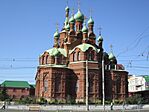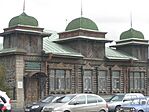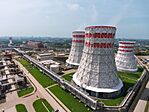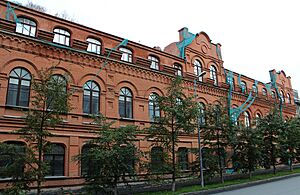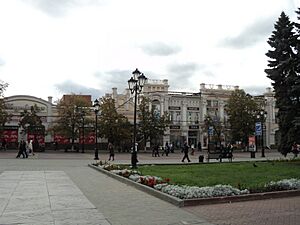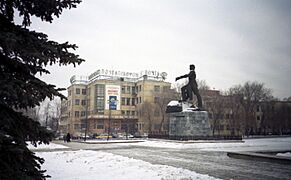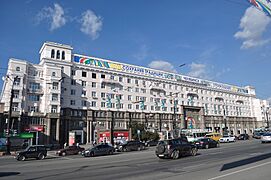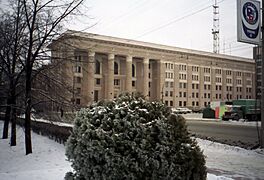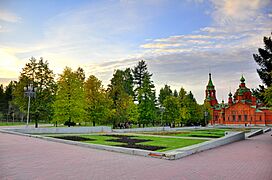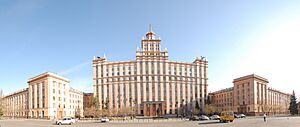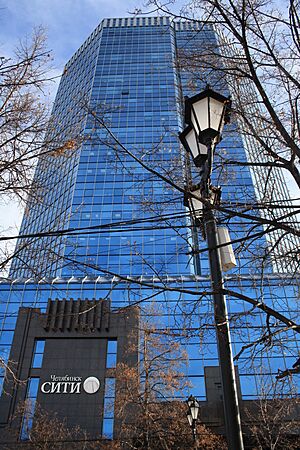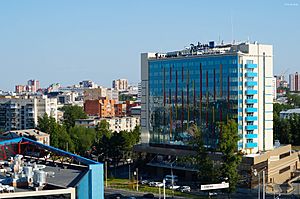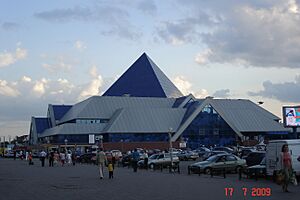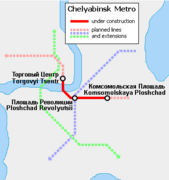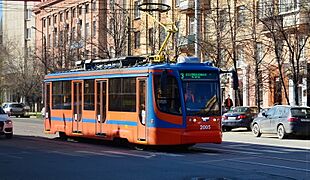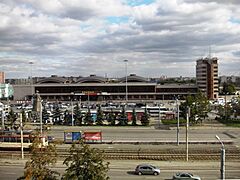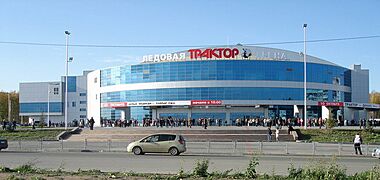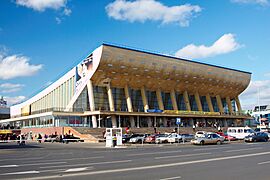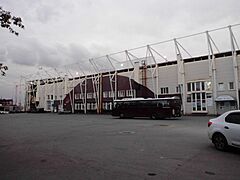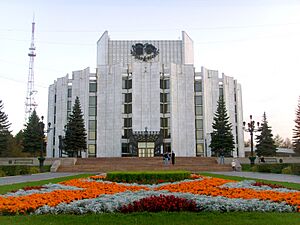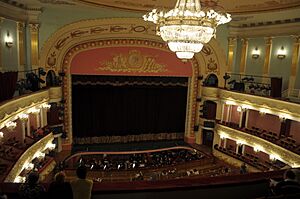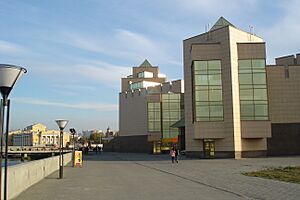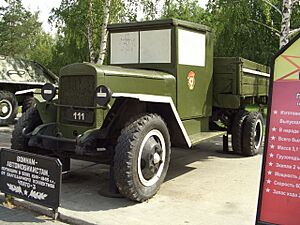Chelyabinsk facts for kids
Quick facts for kids Chelyabinsk (English)Челябинск (Russian) |
|
|---|---|
| - City - | |
| [[File:
From the top to the left: View of Chelyabinsk, Trinity Church, TDK Building, Ryabanin house, Fortum power plant, Trade center.
|250px]] |
|
|
|
|
| City Day | September 13 |
| Administrative status | |
| Country | Russia |
| Federal subject | Chelyabinsk Oblast |
| Administratively subordinated to | City of Chelyabinsk |
| Municipal status | |
| Urban okrug | Chelyabinsky Urban Okrug |
| Head | Natalya Kotova (acting) |
| Representative body | Council |
| Statistics | |
| Area | 530 km2 (200 sq mi) |
| Population (2010 Census, preliminary) |
1,130,132 inhabitants |
| - Rank in 2010 | 9th |
| Population (2013 est.) | 1,156,201 inhabitants |
| Density | 2,132/km2 (5,522/sq mi) |
| Time zone | YEKT (UTC+06:00) |
| Founded | 1736 |
| City status since | 1787 |
| Postal code(s) | 454xxx |
| Dialing code(s) | +7 351 |
| Official website: http://www.cheladmin.ru | |
Chelyabinsk is a big city in Russia. It is the main city of Chelyabinsk Oblast. It is the seventh-largest city in Russia, with over 1.1 million people. Chelyabinsk is located east of the Ural Mountains, along the Miass River.
Long ago, the area had an ancient settlement called Arkaim. In 1736, a fortress named Chelyaba was built here. Chelyabinsk became a town by 1787. The city grew quickly in the early 1900s. This happened because new railway lines, like the Trans-Siberian Railway, connected it to other parts of Russia.
During the time of the Soviet Union, Chelyabinsk became a major industrial center in the 1930s. The Chelyabinsk Tractor Plant was built in 1933. During World War II, the city made many tanks and ammunition. Today, Chelyabinsk is still a big industrial city. It is known for making metal products and military equipment. It also has several universities, like South Ural State University.
Contents
History of Chelyabinsk
Ancient Civilizations in Chelyabinsk
Archaeologists found old town ruins near Chelyabinsk. These ruins, like Arkaim, show that an advanced civilization lived here around 2000 BC. These people were likely early proto-Indo-Iranian groups.
The Arkaim site is part of the Sintashta-Petrovka culture. This culture spread across the eastern Urals. Their towns were often round, square, or oval. These sites had strong defenses, connected houses, and a lot of metalworking.
People of the Sintashta culture probably spoke an early form of Indo-Iranian. This idea comes from studying their language and burial customs.
Modern Russian History of Chelyabinsk
The Chelyaba fortress was built in 1736. It was named after a local village. Colonel Alexey Tevkelev built it to protect trade routes. In 1774, the fortress was attacked during Pugachev's Rebellion. It was captured for a few months in 1775. Chelyabinsk became a town in 1787.
Chelyabinsk was a small town until the late 1800s. In 1892, the Samara-Zlatoust Railway connected it to Moscow. Also in 1892, work on the Trans-Siberian Railway began in Chelyabinsk. By 1896, it was linked to Ekaterinburg. Chelyabinsk became a major travel hub for Siberia. Millions of people passed through the city. Many stayed, helping the city grow fast.
A "customs fracture" was set up in Chelyabinsk. This meant taxes were put on goods moving between European and Asian Russia. This led to many factories opening, like a tea-packing factory. Chelyabinsk became a big trade center. Its population grew from 20,000 in 1897 to 70,000 by 1917. Because it grew so quickly, Chelyabinsk was sometimes called "the Chicago of the Urals."
In the 1930s, during the Soviet Union's first five-year plans, Chelyabinsk grew industrially. Important factories like the Chelyabinsk Tractor Plant were built. During World War II, many Soviet factories were moved here. This was to keep them safe from the German army. Chelyabinsk started making T-34 tanks and Katyusha rocket launchers. The city's factories produced 18,000 tanks and millions of ammunition units. Because of this, Chelyabinsk was called "Tankograd" (Tank City).
2013 Chelyabinsk Meteor Event
On February 15, 2013, a large meteor entered Earth's atmosphere. It traveled very fast, over 55,000 kilometers per hour. The meteor exploded high above the Ural Mountains.
The explosion caused a bright flash, like the sun. It also created a powerful shock wave. This shock wave injured over a thousand people. Most injuries were from broken glass. Pieces of the meteor fell in and around Chelyabinsk. The explosion was very strong, much more powerful than the atomic bomb used in Hiroshima. The city was lucky that the meteor exploded so high up. This spread its energy over a wider area, preventing more damage.
Chelyabinsk City Layout
Chelyabinsk is located east of the Ural Mountains. It is about 200 meters above sea level. The Miass River flows through the city. This river is seen as the border between the Urals and Siberia.
The Leningrad Bridge crosses the Miass River. It is known as "the bridge between the Urals and Siberia." Chelyabinsk itself is sometimes called "the gateway to Siberia." Like some other famous cities, Chelyabinsk is said to be built on seven hills.
The city started as a fortress in 1736. The first streets appeared soon after. Over time, the city grew with new plans. During the Soviet era, many large factories were built. New neighborhoods like Metallurgichesky and Traktorozavodsky grew around these factories. The city continued to expand, adding more residential areas and improving its transport system.
Chelyabinsk Climate
Chelyabinsk has a humid continental climate. This means it has cold winters and warm summers. The average temperature in January is around -14.9°C (5.2°F). July is warmer, with an average of 19°C (66.2°F). The yearly average is about 3°C (37.4°F). Temperatures can change a lot, showing it's a true continental climate.
Most rain and snow falls in the summer. July is the wettest month, with about 87 mm (3.4 inches) of rain. January is the driest, with only about 15 mm (0.6 inches). The city gets about 429 mm (16.9 inches) of precipitation each year. On average, it rains or snows about 119 days a year.
| Climate data for Chelyabinsk | |||||||||||||
|---|---|---|---|---|---|---|---|---|---|---|---|---|---|
| Month | Jan | Feb | Mar | Apr | May | Jun | Jul | Aug | Sep | Oct | Nov | Dec | Year |
| Record high °C (°F) | 4.9 (40.8) |
5.6 (42.1) |
19.9 (67.8) |
34.9 (94.8) |
39.9 (103.8) |
39.9 (103.8) |
39.9 (103.8) |
39.9 (103.8) |
34.9 (94.8) |
24.9 (76.8) |
14.9 (58.8) |
9.9 (49.8) |
39.9 (103.8) |
| Mean daily maximum °C (°F) | −10.5 (13.1) |
−7.9 (17.8) |
1.0 (33.8) |
10.6 (51.1) |
20.3 (68.5) |
24.0 (75.2) |
25.2 (77.4) |
23.6 (74.5) |
17.2 (63.0) |
9.3 (48.7) |
−0.4 (31.3) |
−6.9 (19.6) |
8.8 (47.8) |
| Daily mean °C (°F) | −14.9 (5.2) |
−13.4 (7.9) |
−4.8 (23.4) |
4.7 (40.5) |
12.1 (53.8) |
18.3 (64.9) |
19.3 (66.7) |
17.1 (62.8) |
10.9 (51.6) |
4.1 (39.4) |
−5.2 (22.6) |
−11.1 (12.0) |
3.0 (37.4) |
| Mean daily minimum °C (°F) | −19.0 (−2.2) |
−18.9 (−2.0) |
−9.3 (15.3) |
−0.3 (31.5) |
7.9 (46.2) |
12.9 (55.2) |
14.5 (58.1) |
13.5 (56.3) |
7.6 (45.7) |
1.3 (34.3) |
−5.9 (21.4) |
−14.6 (5.7) |
−0.9 (30.4) |
| Record low °C (°F) | −49.9 (−57.8) |
−44.9 (−48.8) |
−44.9 (−48.8) |
−29.9 (−21.8) |
−19.9 (−3.8) |
−4.9 (23.2) |
0.1 (32.2) |
0.1 (32.2) |
−9.9 (14.2) |
−24.9 (−12.8) |
−39.9 (−39.8) |
−44.9 (−48.8) |
−49.9 (−57.8) |
| Average precipitation mm (inches) | 17 (0.7) |
16 (0.6) |
19 (0.7) |
27 (1.1) |
47 (1.9) |
55 (2.2) |
87 (3.4) |
44 (1.7) |
41 (1.6) |
30 (1.2) |
26 (1.0) |
21 (0.8) |
430 (16.9) |
| Average rainy days | 0.1 | 0.3 | 4 | 10 | 15 | 19 | 17 | 16 | 16 | 10 | 6 | 1 | 114 |
| Average snowy days | 18 | 16 | 15 | 6 | 1 | 0.3 | 0 | 0 | 1 | 6 | 15 | 19 | 97 |
| Average relative humidity (%) | 85 | 77 | 76 | 66 | 61 | 64 | 69 | 71 | 73 | 73 | 82 | 83 | 73 |
| Source 1: Pogoda.ru.net | |||||||||||||
| Source 2: World Meteorological Organization (precipitation days only) | |||||||||||||
Chelyabinsk Population
| Historical population | ||
|---|---|---|
| Year | Pop. | ±% |
| 1897 | 20,000 | — |
| 1926 | 57,655 | +188.3% |
| 1939 | 273,116 | +373.7% |
| 1959 | 689,049 | +152.3% |
| 1970 | 875,210 | +27.0% |
| 1979 | 1,029,522 | +17.6% |
| 1989 | 1,141,777 | +10.9% |
| 2002 | 1,077,174 | −5.7% |
| 2010 | 1,130,132 | +4.9% |
| 2021 | 1,189,525 | +5.3% |
| Source: Census data | ||
In 2010, the city's population was over 1 million people. Most people in Chelyabinsk are Russians. Other groups include Tatars and Bashkirs.
| Ethnicity | Population | Percentage |
|---|---|---|
| Russians | 936,457 | 86.5% |
| Tatars | 54,400 | 5.0% |
| Bashkirs | 33,716 | 3.1% |
| Ukrainians | 15,638 | 1.4% |
| Others | 42,058 | 3.9% |
Chelyabinsk City Life
Chelyabinsk Architecture
The buildings in Chelyabinsk show its long history. Before 1917, it was a trading city. Many old merchant buildings can still be seen on Kirovka Street.
In the late 1920s, many factories were built. New homes and public buildings, like the main post office, were also constructed. You can see many buildings from this time near the Chelyabinsk Tractor Plant.
Later, in the 1930s, a new style of building became popular. Many buildings in the city center are built in this grand style. As the city grew, more tall apartment buildings were built. In recent years, new office buildings and shopping malls have been added.
Chelyabinsk Parks and Gardens
Chelyabinsk has 17 public parks. The biggest one is Gagarin Central Park. It has rocky areas and forests. There are also old quarries that are now filled with water.
Chelyabinsk Education
Chelyabinsk has many universities. The oldest, Chelyabinsk State Agroengineering Academy, started in 1930. Another important one is Chelyabinsk State Pedagogical University, founded in 1934. Other major universities include South Ural State University and Chelyabinsk State University. After World War II, Chelyabinsk became a key place for job training in the Ural region.
Chelyabinsk Economy
Chelyabinsk is a big industrial city in Russia. It is known for making metal products and military equipment. Large companies like Chelyabinsk Metallurgical Combinate (CMK) are here. Other important factories include the Chelyabinsk Tractor Plant (CTZ). This plant makes tractors and other machines. The Chelyabinsk Zinc Plant produces a lot of the world's zinc.
The Molnija Watch Factory makes pocket watches. They also make special watches for planes and ships. In 1980, Molnija watches were given as gifts at the Moscow Olympic Games.
Makfa is a large company that makes pasta. It is based in Chelyabinsk. Unichel Footwear Firm, a big shoe maker, also has a factory here. The American company Emerson Electric works with a local company called Metran. They make industrial equipment.
Chelyabinsk also has many insurance companies and banks. There are several large shopping malls in the city. Some of the biggest are Gorky and Rodnik.
Chelyabinsk Transportation
Public transport in Chelyabinsk includes buses, trams, and trolleybuses. There are also private mini-buses called marshrutka. The city has many taxi companies.
Since 2014, Chelyabinsk has electric buses and trolleybuses. Some public trams and trolleybuses offer free Wi-Fi.
Chelyabinsk started building a subway system in 1992. However, it has never been finished. The city also has the Chelyabinsk Airport.
Chelyabinsk Sports
Several sports clubs are active in Chelyabinsk:
| Club | Sport | Founded | Current League | League Rank |
Stadium |
|---|---|---|---|---|---|
| Traktor Chelyabinsk | Ice Hockey | 1947 | Kontinental Hockey League | 1st | Traktor Arena |
| Chelmet Chelyabinsk | Ice Hockey | 1948 | Higher Hockey League | 2nd | Yunost Sports Palace |
| Belye Medvedi Chelyabinsk | Ice Hockey | 2009 | Junior Hockey League | Jr. 1st | Traktor Arena |
| FC Chelyabinsk | Football | 1977 | Russian Second Division | 3rd | Central Stadium |
| Sintur Chelyabinsk | Futsal | 1997 | Futsal Supreme League | 2nd | USURT Sports Complex |
| Dynamo-Metar Chelyabinsk | Volleyball | 1972 | Women's Volleyball Superleague | 1st | Metar-Sport Sports Palace |
| Dynamo Chelyabinsk | Volleyball | 1986 | Men's Volleyball Supreme League | 2nd | Metar-Sport Sports Palace |
Chelyabinsk has hosted many important sports events. These include the 2012 European Judo Championships and the 2014 World Judo Championships. It also hosted the 2015 World Taekwondo Championships. In 2018, Chelyabinsk hosted the IIHF World U18 Championship for ice hockey.
Chelyabinsk Culture
The city has several libraries. The Chelyabinsk Regional Universal Scientific Library is the largest public library in the region. It has over 2 million books, including many rare old books.
Chelyabinsk is home to many theaters. The Chelyabinsk Opera and Ballet Theatre opened in 1956. Other theaters include the Nahum Orlov State Academic Drama Theatre and the Chelyabinsk State Puppet Theater.
There are nine museums in Chelyabinsk. The Chelyabinsk Regional Museum has about 300,000 items. You can see things from the ancient settlement of Arkaim there. It also has a large piece of the Chelyabinsk meteor.
The Chelyabinsk Regional Picture Gallery has over 11,000 artworks. It shows Russian, European, and international art. The museum also has old religious icons and ancient books.
The Museum of History of the Southern Ural Railway shows equipment used on the railway since 1892.

The Museum of Military Equipment in the Garden of Victory opened in 2007. It has 16 exhibits, including T-34 tanks and Katyusha rocket launchers made in Chelyabinsk during World War II.
The Chelyabinsk Zoo has over 110 types of animals. Many of these animals are endangered. The zoo helps protect animals like Siberian tigers and polar bears.
Other cultural places include the Chelyabinsk State Circus and the Chelyabinsk State Philharmonic Concert Hall. Chelyabinsk also has several churches built over the last two centuries.
Notable people from Chelyabinsk
- Roman Abalin (born 1998), YouTuber
- Ariel, Soviet pop rock band
- Lera Auerbach (born 1973), composer and musician
- Svyatoslav Belza (1942–2014), musical scholar and critic
- Anatoliy Kroll (born 1943), jazz musician
- Zhan Bush (born 1993), figure skater
- Dmitry Shishkin (born 1992), Classical Pianist
- Yekaterina Gamova (born 1980), Olympic volleyball player
- Makhmut Gareev (1923–2019), historian and military scientist
- Sidney Gordin (1918–1996), artist and professor
- Viktor Khristenko (born 1957), politician
- Igor Kurnosov (1985–2013), chess grandmaster
- Oleg Mityaev (born 1956), singer-songwriter and actor
- Vadim Muntagirov (born 1990), ballet dancer
- Staņislavs Olijars (born 1979), Latvian hurdler
- Georgy Ratner (1923–2001), surgeon
- Nelli Rokita (born 1957), Polish politician
- Eugene Roshal (born 1972), software developer
- Mariya Savinova (born 1985), Olympic athlete
- Galina Starovoytova (1946–1998), politician and human rights activist
- Maksim Surayev (born 1972), cosmonaut
- Evgeny Sveshnikov (born 1950), chess grandmaster
- Anna Trebunskaya (born 1980), dancer
- Ivan Ukhov (born 1986), Olympic high jumper
- Mikhail Yurevich (born 1969), businessman and politician
- Mikhail Koklyaev (born 1978), strongman competitor
Ice hockey players from Chelyabinsk
- Sergei Babinov (born 1955), Soviet player
- Sergei Starikov (born 1958), Soviet Olympian and NHL player
- Vyacheslav Bykov (born 1960), Soviet player
- Stanislav Chistov (born 1983), NHL and KHL player
- Evgeny Davydov (born 1967), NHL player
- Radmir Faizov (born 1977), Russian Superleague player
- Sergei Gonchar (born 1974), NHL player, Stanley Cup champion
- Dmitri Kalinin (born 1980), NHL and KHL player
- Alexandra Vafina (born 1990), Russian Olympic ice hockey player
- Evgeny Kuznetsov (born 1992), NHL and KHL player, Stanley Cup champion
- Sergei Makarov (born 1958), NHL player
- Andrei Nazarov (born 1974), NHL player and KHL coach
- Nikita Nesterov (born 1993), NHL and KHL player
- Valeri Nichushkin (born 1995), NHL and KHL player, Stanley Cup champion
- Valeri Karpov (1971–2014), Russian Superleague and NHL player
- Dmitri Tertyshny (1976–1999), Russian Superleague and NHL player
- Slava Voynov (born 1990), NHL player, Stanley Cup champion
- Danil Yerdakov (born 1989), KHL player
- Danis Zaripov (born 1981), KHL player, Gagarin Cup champion
- Yakov Trenin (born 1997), NHL player
International Connections
Sister Cities of Chelyabinsk
Chelyabinsk has "sister city" relationships with other cities around the world. This means they share cultural and educational ties.
 Nottinghamshire, United Kingdom
Nottinghamshire, United Kingdom Ramla, Israel
Ramla, Israel Ürümqi, China
Ürümqi, China Columbia, South Carolina, United States
Columbia, South Carolina, United States
See also
 In Spanish: Cheliábinsk para niños
In Spanish: Cheliábinsk para niños



